Discover Thai Regional Cuisine and Fermented Seasoning
Dec 10,2020
Discover Thai Regional Cuisine and Fermented Seasoning
Dec 10,2020
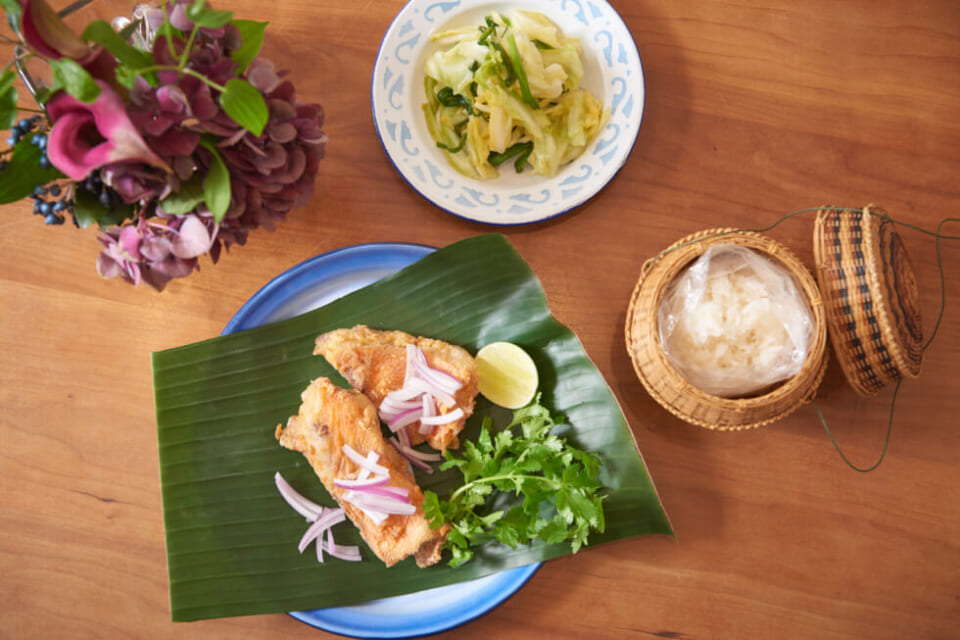

Spicy dishes like tom yum kung and green curry are geenrally what come to mind first at the mention of Thai cuisine. But another of its attractions is the kaleidoscope of sweet and sour flavors it offers. Indispensable to producing this varied taste experience is Thailand’s wealth of fermented seasonings, including one well known in Japan — nam pla.
To learn more about the connection between Thai cuisine and fermented seasonings, we talked with Thai cooking expert Nagasawa Megumi, who runs Tit Cai Thai Food cooking school in the Kinshicho district of Tokyo. She also appears frequently on TV and in magazines and other media.
Megumi, who now has a successful career as a Thai cooking expert, first became fascinated with Thai cuisine because there was so much more to it than met the eye.
“Thai cuisine has many regional specialties that are unknown in Japan. Sweet, salty, and sour come together in perfect harmony with spiciness, umami, and aroma to create a single dish. That’s the great thing about it. Thailand has always been known as a land of rice and fish. True to that description, Thai food features rice as the staple, plus generous amounts of fermented seasonings made from fish and shellfish.”

Thai cooking expert Nagasawa Megumi
Thailand, a long, narrow country extending from north to south, is divided into four main regions: the north, the northeast, central Thailand, and the south. Each has its own distinctive regional cuisine and fermented seasonings rooted in its climate, geographical conditions, and the foodstuffs harvested there.
“Northern Thai cuisine, which is heavily influenced by that of neighboring Shan State in Myanmar and Yunnan Province in China, is characterized by its mild flavor. Northeast Thai cuisine bears a strong resemblance to that of Laos across the border. Also known as Isan cuisine, it’s spicy, sour, and heavily flavored, and generally eaten with khao niao (sticky rice). Central Thai cuisine is influenced by the refined cuisine of the royal court and Chinese Teochew cuisine. Southern Thai cuisine has a lot in common with Malay food, since the region abuts Malaysia and is blessed with an abundance of seafood. Fermented seasonings rooted in the land are indispensable to the food cultures of all four regions.”
How then do the fermented seasonings of the four regions differ? Megumi explains.
“Pla ra is essential to northern and northeastern Thai cuisine. It’s a condiment made by fermenting any of a variety of freshwater fish, chiefly a small freshwater fish called pla-kra-dee, in salt and rice flour. Rice bran may be used in place of rice flour. It’s like Japanese heshiko (fish pickled in rice-bran paste). Its flavor varies considerably depending on who makes it. So even among the locals, preferences differ depending on who is doing the cooking .”
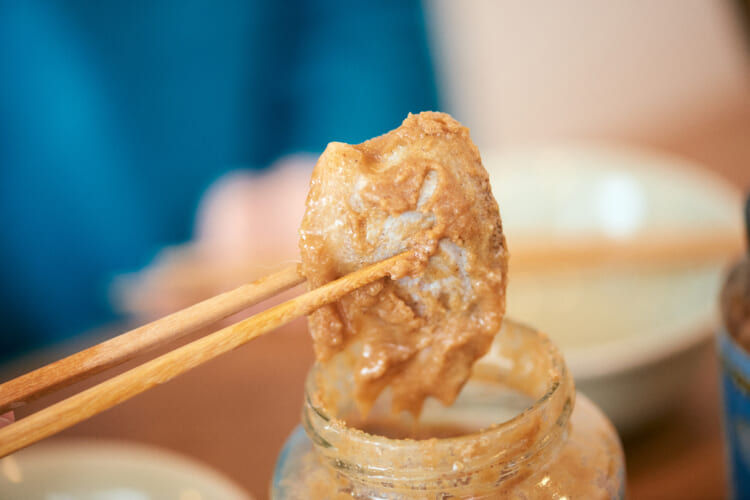
Pla ra, a fermented seasoning indispensable to Isan cuisine. It retains the shape of the fish.
Pla ra is also essential to som tam, a type of salad made using a mortar and pestle. Besides pla ra, in the north there’s a seasoning called nam poo, which is made by crushing freshwater crabs and fermenting and then boiling the juice. Using a type of fermented soybeans called thua nao as a condiment is another feature of northern Thai cuisine. So not all seasonings are made from fish or shellfish.
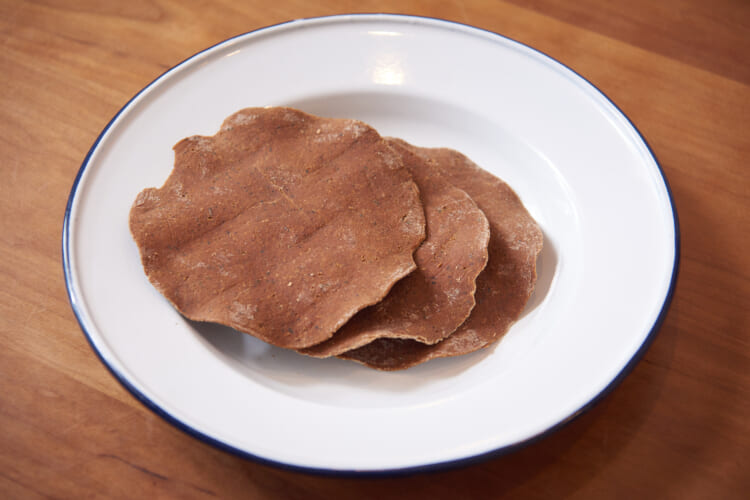
Thua nao, a northern seasoning made by turning fermented soybeans into a paste, then drying it in thin disks.
The most widely used fish- and shellfish-based seasonings in Central Thailand, where the capital Bangkok is located, are kapi, or fermented shrimp paste, and nam pla, or fish sauce. These are the equivalent of miso and soy sauce in Japan. They’re both all-purpose seasonings used to flavor just about anything. Whereas fermented seasonings in the north and northeast are made from freshwater fish caught inland, kapi and nam pla are primarily made from small saltwater fish or from krill.
Kapi is made by washing krill, then letting it sit for about two days until it starts to smell. It is then mixed with salt, turned into a paste, and fermented and aged for at least a year. Again, its flavor varies significantly depending on who makes it.
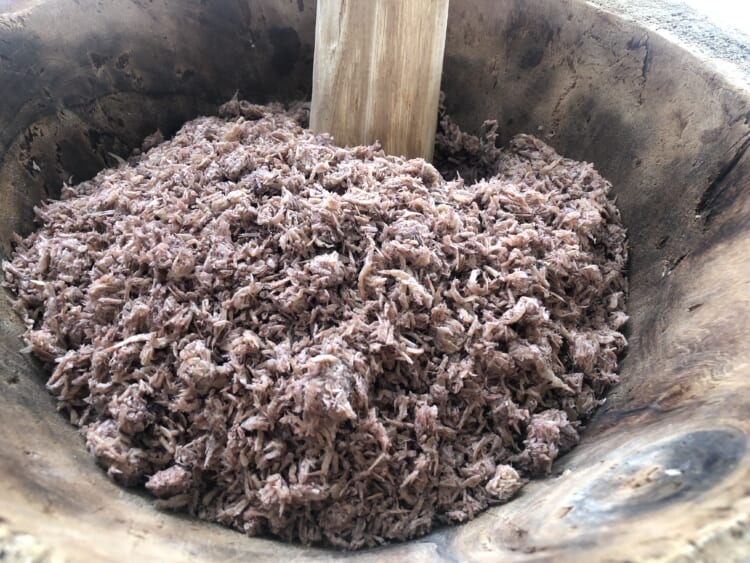
Producing kapi in Thailand. It’s made by mixing krill with salt, then pounding it in a mortar.
“Trat province, which is on the ocean, abounds in shrimp and krill. It’s also renowned for its kapi. I learned how to make it from local producers when I visited the village of Mai Rut in Trat.”
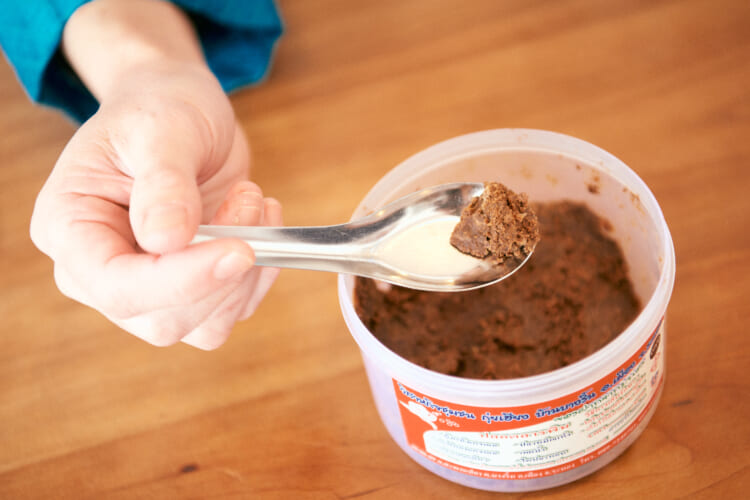
Far from having an off-putting smell, it tastes surprisingly good. It bursts in your mouth with the flavor and umami of shrimp. It would make a great snack with a drink!
Kapi is widely used for flavoring soups and curries, including green curry, a favorite in Japan. There’s also the dipping sauce nam prik kapi, which tastes exquisite on deep-fried eggplant.
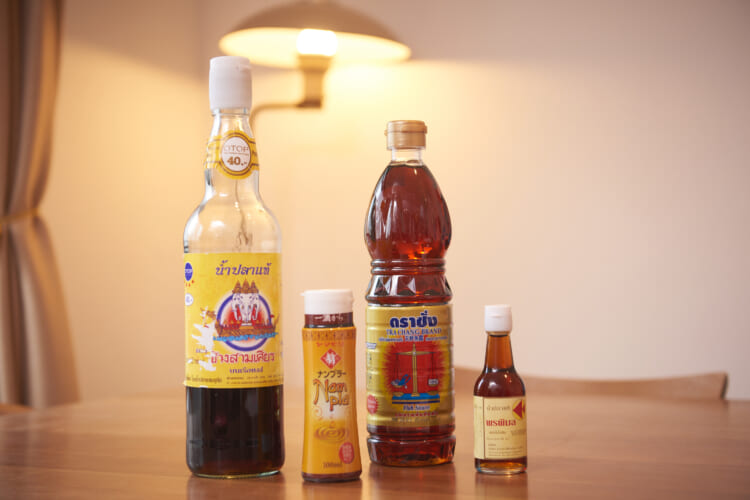
“It’s a waste to use truly great-tasting nam pla in cooked foods,” says Megumi.
The hottest and spiciest of Thailand’s four regional cuisines is that of the south. The most characteristic fermented seasoning of the region is nam budu. This resembles nam pla, only it’s darker and cloudier and has a different taste. That’s because it’s less salty than nam pla and aged for a shorter time.
Nam budu is used as a sauce for dishes like khao yam or rice salad, a favorite among Thai food aficionados in Japan. Megumi once ate khao yam in Pattani province in the south, and she can’t forget how good it tasted.
“The south of Thailand, which is sandwiched between the Gulf of Thailand and the Andaman Sea, teems with fish and shellfish. There are fermented seasonings only found in the south, like kapi made with fish rather than shrimp, and tai pla or fermented fish entrails. One well-known southern specialty is kaeng tai pla, a curry made with tai pla.”
Thailand doesn’t just have fermented seasonings; it also has some truly exquisite fermented dishes.
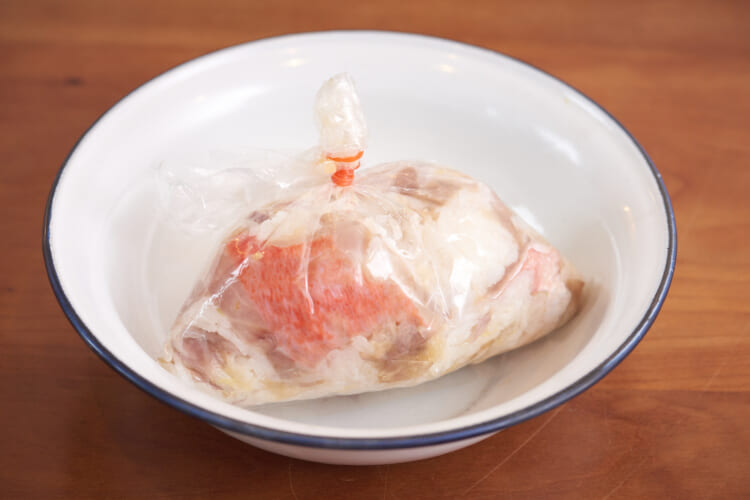
Pla som (fermented fish) made by Megumi herself
Pla som is a dish of the Isan region made by coating fish in salt, garlic, and cooked rice, then letting it ferment. It’s closely akin to Japanese funazushi or fermented crucian carp, for which Lake Biwa is famous.
For this feature, Megumi served pla som made with a fish called the splendid alfonsino. She deep-fried it to a nice color, then dished up on a plate with red onions and coriander. It was accompanied by som phak or pickled vegetables and sticky rice.
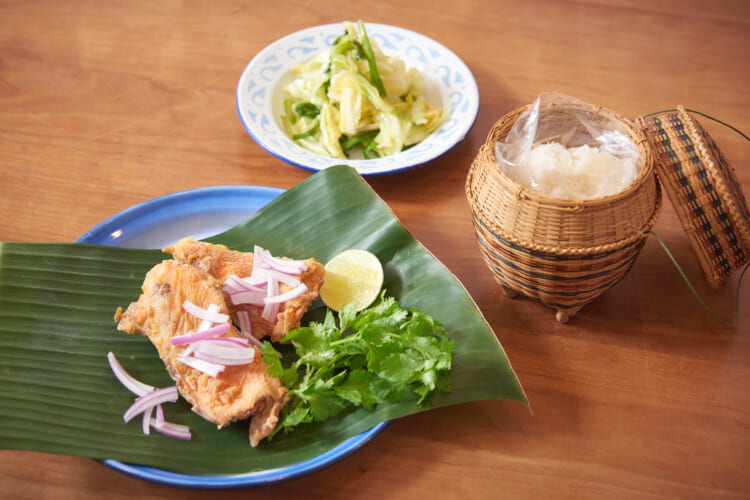
Thailand also has fermented meat dishes like naem, a type of fermented sausage. Megumi often trains in restaurant kitchens in Thailand to expand her knowledge of Thai cuisine. She was particularly impressed with the technique of fermenting meat she observed at one popular Bangkok eatery.
“When fermenting the meat, they skillfully controlled the process to get the umami and acidity just right, while making various adjustments in the temperature and fermentation time. And they didn’t just use traditional Thai fermenting methods. They had also adopted American dry aging technology. It was fascinating to watch.”
Lately, Megumi has been busy investigating the food cultures of neighboring regions like Laos and Yunnan, which have much in common with Thai cuisine. But that hasn’t in the least affected her commitment to making people in Japan aware of the great taste of Thai cuisine through her cooking classes and media appearances.
“Thai cuisine and Japanese cuisine, I feel, have many similarities. Both food cultures revolve around rice and fish, and both are rich in fermented foods. The one big difference is that Thai cuisine strikes a balance by adding sweet, salty, sour, spicy, umami, and aroma, whereas Japanese cuisine is about refining the flavor through subtraction. Still, they’re similar in their fundamentals. Thai cuisine isn’t just spicy. It has many elements that appeal to the Japanese palate. That’s the message I want to keep getting across.”

A native of Chiba Prefecture, Nagasawa Megumi started a new career specializing in Thai cuisine after falling in love with it on a visit to the country. She learned the basics at a Thai restaurant in Japan. She then trained at cooking schools and restaurants across Thailand, mastering Thai cooking and the Thai language by immersing herself in both. She runs the Thai cooking school Tit Cat Thai Food. She also conducts product development for corporate clients.